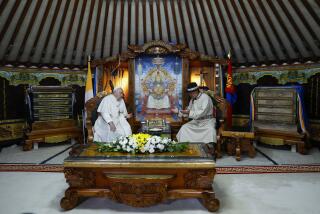Culture : Mongolia Looks Back in Pride at Fabled City : * The ancient capital of Karakorum was a symbol of glory. Today, it is in ruins, though there is talk of restoration.
- Share via
KARAKORUM, Mongolia — This dirt-road town of rugged horsemen and felt-tent homes exudes the mystique of ancient fables, of vague grandeur nearly lost in the misty reaches of time.
A dozen flat-topped, 4-foot-square stones lie sunken into the earth at the edge of town, amid the burrows of ground squirrels that pockmark the grasslands. These stones, local residents say, are remnants of the 13th-Century palace of Ogedei, son of Genghis Khan and ruler of lands stretching from the Pacific Ocean to the edge of Eastern Europe.
Aside from a proud people’s half-forgotten memories, these ruins are all that remain from that age of Mongol glory: an era when Karakorum--now so tiny, and surrounded by so much emptiness--was capital of one of the greatest empires the world has ever known. Yet this place retains such deep meaning for the Mongolian people that the day could come when a major city is reborn here.
Genghis Khan himself, the nomadic founder of the empire, made Karakorum a key base camp during part of his tumultuous reign. Ogedei formalized its status as the empire’s capital by putting up city walls in 1235 and building a palace.
Today, an ancient 10-foot-long granite tortoise is the most visible marker of the old palace area. Some say it dates from Ogedei’s time. Others believe it was carved in the 16th Century, when the Erdene Zuu Monastery--itself largely destroyed in the 1930s--was built from Karakorum’s ruins.
Kublai Khan, the next famous Mongolian ruler after Ogedei, moved the empire’s capital to Beijing in 1267--a step that helped the Mongols rule a conquered China more effectively but that also contributed to the decline of the Mongolian heartland. Centuries later, Mongolia itself became part of the Qing Dynasty’s Chinese empire. Soviet troops helped wrest it from Chinese control in 1921, but only as a satellite state of Moscow. Now, with the collapse of Soviet power, Mongolia is fully independent again for the first time in 300 years. Free to express feelings of nationalism, its people look back with pride on the time of Genghis Khan and Ogedei.
The temples of Erdene Zuu, just a mile outside today’s Karakorum, are already coming to life again as Buddhist practice revives after decades of persecution.
Many Mongolians are proposing that in the next century, once Mongolia solves its current economic difficulties and becomes more prosperous, the national capital should be moved back to Karakorum.
“Some newspaper articles have been written suggesting that the capital be moved to Karakorum--that Ulan Bator (the current capital, 200 miles to the east) remain an industrial city,” noted a Mongolian Foreign Ministry official. “It is just a dream. But many people would like it.”
Karakorum today feels like a village. With a population of 11,000, it has about a dozen multistory concrete structures and an asphalt road through its center. But it consists mostly of the traditional yurt homes of nomadic herders: wool tents more or less permanently pitched in bare yards separated from each other and the earthen streets by high wooden stockade fences.
“It is of course great to live at Genghis Khan’s original place,” said Luvsmaa, 48, a Karakorum resident who like many Mongolians uses just one name. She expressed hope that someday a monument will be built here in Genghis’ honor.
Luvsmaa, who shared her thoughts as she cooked over a coal-fired stove, also expressed hope that as Mongolia opens more to the outside, foreigners will help bring new prosperity to her hometown.
“The Mongolian people like to receive foreigners,” she said. “This is a tradition.”
Partly out of deference to Mongolia’s Russian allies and benefactors--whose ancestors suffered mightily at the hands of the Mongols--and partly out of communist ideology, Genghis Khan’s memory was not honored here for many decades.
“In school I was told, of course, that Genghis Khan was very bad,” said Luvsmaa’s teen-age son, Erdenebat. “But now everybody in Mongolia is talking about Genghis Khan. I think he was not a bad man. He was good for Mongolia. His heart was for the Mongolian people.”
Budragchagyn Dashyondon, chairman of the ruling Mongolian People’s Revolutionary Party, which used to consider itself communist but now advocates multi-party democracy and capitalism, offered his view of Genghis Khan in an interview.
“Genghis Khan founded the Mongolian state,” Dashyondon said. “He united the Mongolian tribes. By uniting them, he protected them from neighboring powers, and thanks to that fact, we inherited this land. That is one side. On the other hand, we should not whiten or approve all of the wars that he carried out . . . . But we should pay respect to Genghis Khan.”
When asked about Karakorum, Dashyondon launched into an elegant description of its ancient wonders.
“In the very center of the city there was a silver fountain,” he said. “It was very tall, and on the top of the fountain was a statue of a man with a horn. There were five pipes, and from these five pipes flowed five kinds of drinks: honey, milk, wine, mineral water and fermented mare’s milk. The flow of these five drinks made a sound. The city had many castles, temples and other buildings. But there are none of them now.”
Dashyondon also believes it is likely that someday, perhaps many decades from now, the Mongolian people will indeed restore the ancient capital. Even the silver fountain, he said, should be rebuilt.
“Karakorum,” he declared, “is a cultural heritage for all mankind--not only Mongolians.”
More to Read
Sign up for Essential California
The most important California stories and recommendations in your inbox every morning.
You may occasionally receive promotional content from the Los Angeles Times.













